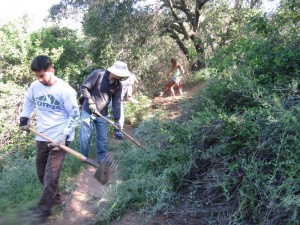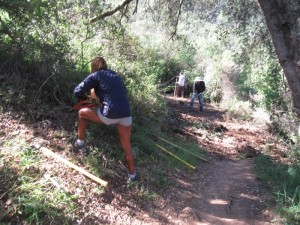We had an unusually poor turnout for our trail restoration project along the Backbone Trail between Kanan and Latigo Canyon Roads. Even so, our small group of five (4 mountain bikers and one trail runner) got a lot done, and along with the dozen or so volunteers from our partners with the Santa Monica Mountains Trails Council, we worked about a mile of trail, starting on the top of the tunnel just past the first steep hill out of the parking area. The poor turnout of mountain bikers was a real disappointment, especially because this is such a great and popular trail for mountain biking. This is the first leg of the ride between Kanan Road and the Corral Canyon trailhead.
There were three major problems that we needed to address – lack of drains, poorly constructed drains and overgrowing brush that included a lot of poison oak (PO).
We originally scouted this trail about six weeks ago, but we had to scrub that work day because we learned only a couple of days beforehand that there would be a major event that morning, with hundreds of trail runners passing through the work area, and the parking area would be used by support crew.
We scouted the area again last week to flag the spots where we could be working. In just six weeks the amount of growth of the brush, and especially the PO, amazed us!
For dealing with most of the overgrowth, we left that to the Trails Council crew and their gas hedge trimmer. That’s an effective way to quickly deal with overgrowing chaparral and PO. Unlike most brush cuttings that we pick up and dispose of off the trail and out of sight, clippings that contain poison oak are carefully pulled to the side of the trail with a MacLeod (has a 4′ handle) and then shoved over the edge. We try not to touch any part of the handles of our tools to the PO leaves or stems.
The CORBA crew hiked about 1.4 miles to the end of the work area to tackle a corner where there have been mountain bike spills. It turns out that the brush had overgrown the inside of the turn so that the trail had become very narrow and people were riding beyond the outside edge where the dirt was soft. Mixed in with the overgrowing brush were some very vigorous PO bushes. Lacking the gas hedge trimmer, we chopped and hacked the brush around the PO, exposing as much of it as possible, then carefully chopped, hacked and lopped those branches. Where the brush had been removed was about a foot deep of leaf litter, including PO leaves, so we scraped all that away, revealing the original trail tread. Finally, we worked the dirt to give the tread a bit of an outslope (to shed water) and to make it even with the old trail.
That effort took the five of us about an hour and a half. After that, we worked our way back to the beginning, rebuilding blocked drains, filling a few very nasty but short ruts, and building new drains.
Some of the drains we worked turned out to be old drains that were completely filled with dirt. Even thought the trail was on a steep cross-slope, the dirt had piled us several feet off the edge of the trail, like the Mississippi River delta. To make an effective drain, we had to cut down the brush that was growing up around these ‘deltas’ and then push a couple of cubic yards of dirt down the hill. That was before we could even start to construct our typical drainage nicks!
There was a major problem on the first half mile of trail beyond the top of the tunnel. Some person or group had dug poorly designed drains into the trail. They were too narrow and not sloped properly to drain water off the side. The biggest problem was that the outlet at the outside edge of the trail was narrow, so all the water was focused on one spot, eroding a deep rut. With just a few rainfalls, these ruts would start to encroach into the trail and would eventually destroy it. The Trails Council took care of these by widening them out, and also worked on some deeply rutted sections.
Overall we fixed up about a mile of trail, including brushing back the overgrowth. But be careful when riding this trail – the brush and poison oak is growing so quickly that it’s likely to continue to be a problem for some time.






